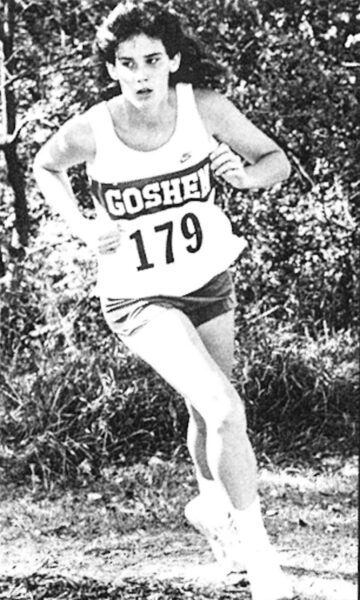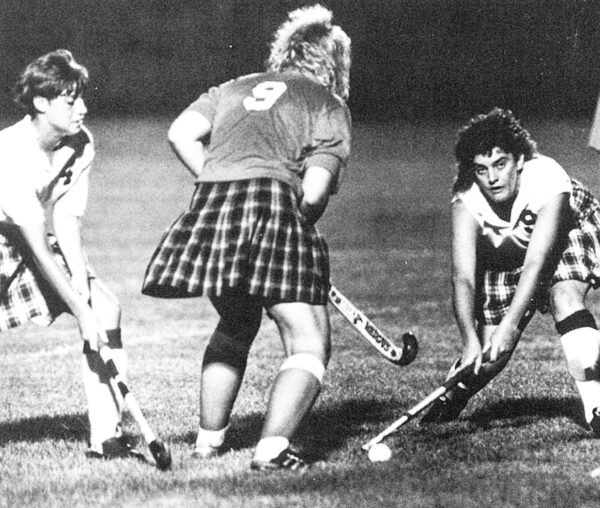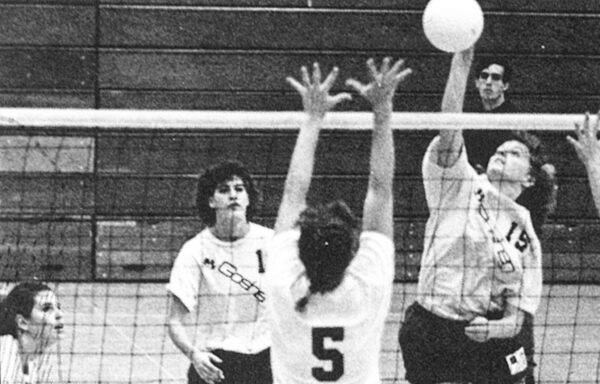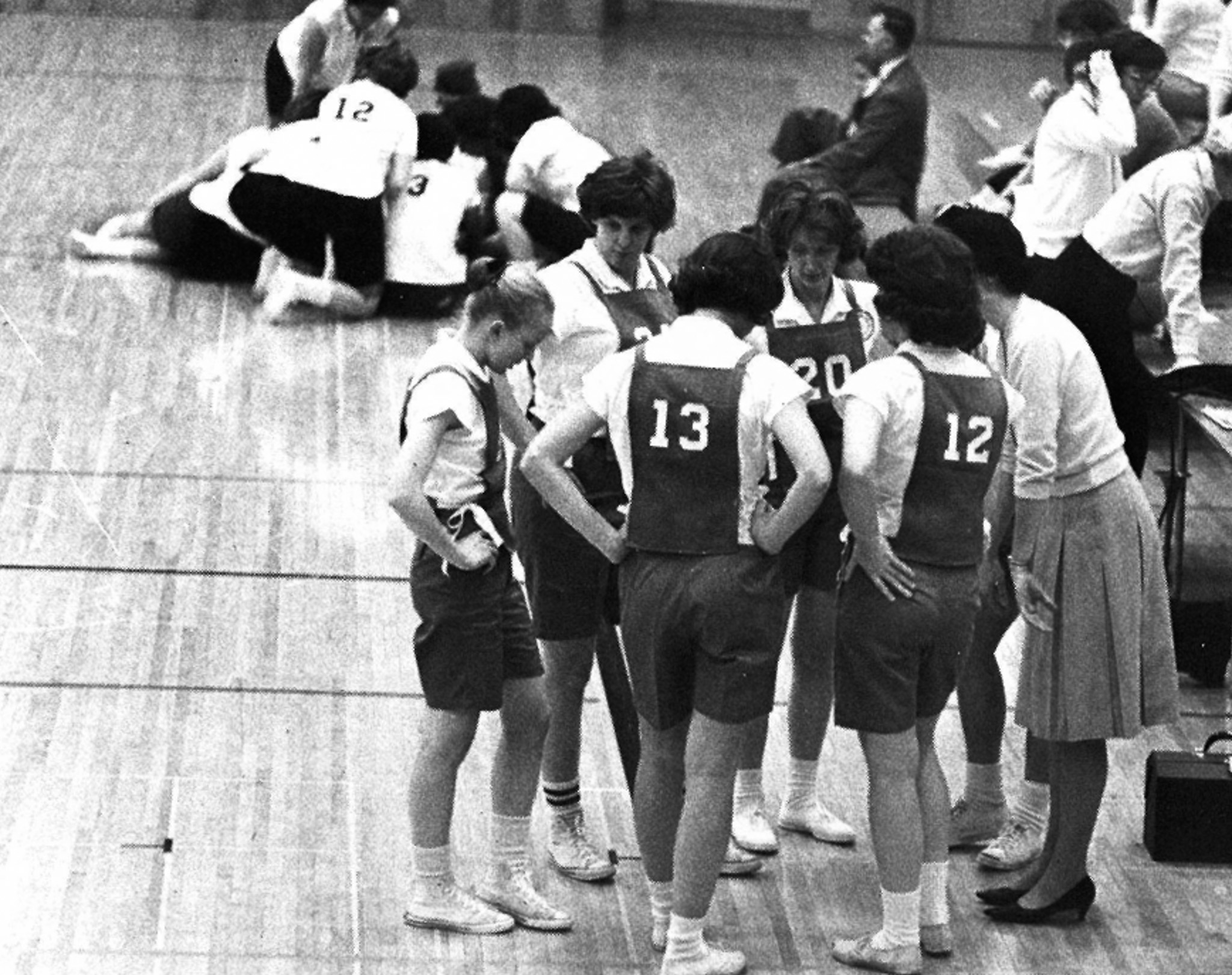 Running at GC began 70 years ago.
Running at GC began 70 years ago.
1921: The Mennonite Board of Education sends out a recommendation that “intercollegiate athletics be forbidden by institutions under the board,” as they “may foster certain false ideals.” The GC board accepted the recommendation.
1922: The ban on athletics falls through. The first gym is built at GC for coed athletic activities through a combined force of student laborers and local Goshenites. Its location stood on the same ground as the current Science Hall, and was described as a vast improvement over the Administration building basement.
1925: All students are now required to participate in at least three hours of weekly physical activity.
1936: A new policy prevents women from playing games in public, thus cancelling the annual alumna game.
1939: Women no longer need to wear long skirts when exercising, they may now wear a uniform.
1950: The union building is constructed, and with it came the union gym, which for several years possessed a divider so that men and women could practice separately. 325 basketball games are played during the first year.
1955: A multi day women’s track meet is documented, including events like baseball throw, basketball throw, 50-yard dash, running broad jump, shot put, standing broad jump, 75-yard dash, discus throw, hop step jump and 440-yard relay. Women’s interclass basketball and softball are being played on campus at this time.
1959: Women receive athletic recognition at the awards banquet for athletics, academics and forensics.
1962: The number of possible schools as competition is limited because GC commits to only playing “Christian colleges which have ideals and standards similar to our own.”
1965: Women’s basketball first appears as a varsity sport under Ruth Gunden, goes 8-1 in their inaugural season — this included beating Indiana University. They have no bus and instead take two station wagons to every game, leading to shenanigans like leaving players behind at gas stations, or Gunden paying for everyone’s meal post game since it was not provided by the college. Other sports have also joined the lineup, as a cheerleading team is now on the scene in support of the men’s basketball team. On top of that, a gymnastics team is recorded as performing in front of the student body, listing their coach as Byron Shenk — six women were involved in its first year. The women’s teams are known as the Leaflets.
1966: Softball is recorded as playing an intercollegiate game against Calvin, though not yet as an official team. The same is true of women’s tennis which is also listed as having extramural games this year. The year book this year includes high praise of the women’s basketball team in combination with a scathing review of past soccer teams: “A winning girl’s basketball team is as traditional at GC as a losing soccer team.” Though notably this is an undefeated season for men’s soccer. In intramurals, the women hold a powder puff football game “in the spirit of protest culture,” and gymnastics is still performing under their coach.
1970: Women’s volleyball begins their inaugural season under Ruth Gunden, going 99-51-1 in their first decade of existence. This is also the year Title IX is instituted nationally and Goshen College continues to move towards equality between sports. John Ingold ’59, former coach of numerous teams at Goshen and namesake of GC’s athletic complex, said that equality was never much of an issue during this era of the college. “Right from the beginning, Roman Gingerich felt that women’s sports were equal to men’s sports — we gave equal time for use of the gym — no problems there,” Ingold said.
1972: This is the first official year of women’s tennis at GC, also led by Ruth Gunden.
1986: Women’s cross country officially begins, and as a result, the administration asks the athletic department to drop a men’s sport so that there would be an equal number of both, but the department’s petition to keep them all succeeds. A survey goes out, strongly considering the potential of bringing back cheerleaders in an effort to “lift school spirit.” Goshen also doesn’t yet have a soccer team, but they are holding a soccer camp that high school girls were encouraged to attend
1989: GC awards its first ever athletic scholarship.
 Field Hockey at GC was led by East Coast players from strong high school programs.
Field Hockey at GC was led by East Coast players from strong high school programs.
1990: Women’s field hockey plays their final season as programs surrounding them rapidly disappear in favor of soccer. Linda “Pert” Shetler ’72, the coach at the time, said “It was the saddest day of my life — when I had to tell my team that this would be the last year for field hockey.” She spoke highly of her time coaching at GC, sharing that her nickname was coined by a field hockey player, standing for “physical education recreation teacher” — this is the name she still goes by today.
Michelle Horning ’91, current professor of accounting and all time leading scorer in GC field hockey history, echoed a similar sentiment. “I was glad it happened my senior year because I got to play all four years.” Other students were not so lucky as the program was indeed cut for the following year — some however went on to play soccer in the initial season, as girls at the time played both in high school.
 In 1991, women’s volleyball was 18-18 under Sue Roth.
In 1991, women’s volleyball was 18-18 under Sue Roth.
1991: Women’s soccer plays their first season under the leadership of Jeff Birky, who is also the head men’s basketball coach. They finish with a record 5-6-1.
1993: Softball plays their first season under head coach Sharon Swartley, who had been a fierce advocate for the team.
1994: The Recreation Fitness Center is opened, replacing the union gym. Melanie Mishler ’97, described the opening of the RFC as one of the highlights of her athletic career at Goshen. “It was so light and big, not old and dark like the union — we just felt so likely to have come to college at the primetime,” Mishler said.
She also explained that the benefits of opening the new gym went beyond just the courts. “The rest of the school became more involved in sports as a result of the new building — sports became much more of a whole campus event.” More than just the building, Mishler also described her basketball team as “an instant community,” upon arriving on campus. The women beat Marian 53-52 in the inaugural game.
Shetler scored a ceremonial first shot on the courts after Dwain Hartzler, RFC building director, missed his.
2012: Women’s golf is added to the list of sports at GC.
2014: Women’s golf is cut.
2024: Women’s bowling is added to the lineup. They ended with a generally successful season.
Ruth Gunden began her work at Goshen College in 1953 as a professor of physical education. This would be the beginning of a trailblazing career as a staunch advocate for women’s sports. She served as the original coach for the women’s basketball team, the women’s tennis team and the women’s volleyball team. During her tenure as the women’s basketball coach, she led the Leafs to victory over schools such as Purdue, Indiana University and The Ohio State University. Ken Pletcher ’70, former athletic director, described Gunden as, “Clearly the top dog” of the department during his time there.
“[Gunden] was clearly a leader in all women’s sports — people at major universities were aware of her — her name was synonymous with women’s sports,” Pletcher said. But Gunden didn’t let that notoriety stop her from connecting with her students, players and colleagues. She would even invite the physical education majors over to her house for dinner. “Everybody liked Ruth — there’s no questions about it,” Pletcher said.
Shetler, who played basketball during her time as a student at GC, said that Gunden could best be described as “an energetic lover of basketball.” Something that Shetler carried into her own coaching and encouraged players with was the idea that “To win the game is great, to play the game is greater, and to love the game is greatest.”
Ingold also spoke highly of Gunden’s character and achievements.“She was a very good person, a good prof,” Ingold said. Gunden was in charge of the national women’s basketball directory, was a key figure in the founding of the Hoosier athletic conference for women and had plenty of friends in high places — including names like Pat Summitt, women’s coach with the most college wins ever at the time of her retirement.
“I just have good memories of Ruth — it’s so well deserved that the gymnasium is named after her,” Ingold said.




